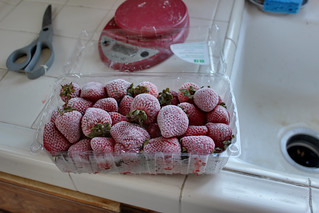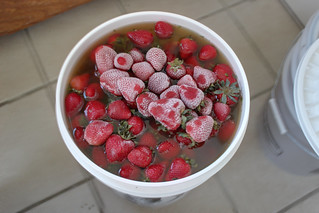Batch 015: Strawberry Elderflower Melomel
We're brewing a comparatively dry mead here using an elderflower tea as water; our plan is to rack it over strawberries in secondary, as strawberries are abundant at the moment. Hopefully, it'll come out fairly quickly and we'll have a nice late-summer carbonated short mead. We'll see. Anyway, we're going to call batch 015 Strawberry Elderflower Melomel.
Brew date: 17 July 2016.
Bottling date: 2 September 2016.
Ingredients in this batch
- 2 oz. dried elderflower, boiled in approx. 1 gal. filtered water.
- 11 lb 9 oz. clover honey from GloryBee
- 2½ tsp ea. Valley Brewers yeast energizer and yeast nutrient./
- filtered tap water to 5.25 gallons
- About ⅘ of a packet of White Labs WLP720 Sweeet Mead/Wine Yeast.
- 10 lbs strawberries, purchased fresh from Costco and frozen before adding into secondary on 11 August
- 1.2 oz dried elderflower, purchased from Hydrobrew in Oceanside and added into secondary on 11 August
Yield: TBA; hopefully about five gallons.
Boiled the elderflower in an herb bag for about half an hour, then let the temperature fall to 140℉. Following Ken Schramm's instructions for lower-temperature must sanitization on page 41 of The Compleat Meadmaker, mixed the honey into the tea, stirring vigorously, and held the temperature at 140℉ to 145℉ for 22 minutes. While this was going on, kept filtering water and adding it to the brewing bucket.
Poured the must into the plastic brewing bucket, then added the rest of the water to bring the total volume up to 5¼ gallons. Mixed in yeast nutrient and energizer, agitated vigorously with the large hard plastic spoon, used the immersion chiller to bring the temperature down to 80℉ (which took nearly 45 minutes), pitched the yeast, measured the gravity, and sealed the bucket with a fermentation lock on top.
Original gravity: 1.085.
Final gravity: 0.990
Estimated ABV: 15%
Observations
- 2016-07-18T10:33:00: There is definitely fermentation in the bucket.
- 2016-08-17T18:15: The strawberries having expanded and filled the bucket and caused mead to flow into the fermentation lock, we pulled off two cups and drank it to make room, then put on a freshly sanitized airlock and let the strawberries continue soaking. The mead itself has a nice, prominent strawberry flavor, and the strawberries are clearly losing color to the mead already.
Secondary Fermentation


We racked this mead into a bucket for secondary fermentation on 9 Aug and froze 10 pounds of fresh strawberries purchased that day. Two days later, we added the strawberries, now thoroughly frozen, along with another 1.2 ounces of dried elderflower. (For the curious, this is the limit of what will fit in a standard steeping sock.) These additions bring the mead dangerously close to the top of the brewing bucket, and we'll have to keep a close eye on it to ensure no mead explosions.
In a first taste test, this mead is surprisingly clean-tasting, with fewer fusel alcohols than other batches and a nice sweetness balance: rather dry, but not too dry. It already has a noticeable, if delicate elderflower aroma, and the generous amount added today should yield pronounced elderflower goodness.
Tasting notes
- 2016-08-17T19:35:00 (during removal of mead to prevent overflow): Rapidly moving toward delicious.